Selection of Spectral Resolution and Scanning Speed for Detecting Green Jujubes Chilling Injury Based on Hyperspectral Reflectance Imaging
Abstract
:Featured Application
Abstract
1. Introduction
2. Materials and Methods
2.1. Green Jujube Sample Collection
2.2. Hyperspectral Images Acquisition and Processing
- (1)
- Compute patch priorities:where and were the confidence term and data term, respectively, and they were defined as:where , , , , , , and were regarded as square template at point to be filled, the area of , unit vector, normalization factor, the isophotes direction at point , entire image, and the target region, respectively.
- (2)
- Once the patch with the highest priority () was found, the texture and structure were propagated by coping the most best-matching patch () in candidate source region to the position based on sum of squared differences (SSD) as:
- (3)
- Update confidence values and repeat step 1–3 until done. Finally, the peak signal-to-noise ratio (PSNR) between the original and inpainting images was calculated to evaluate the performance of inpainting operation.
2.3. Spectral and Textural Features Selection for Green Jujube Chilling Detection
2.4. Discriminant Analysis Method Chilling Injury Detection of Green Jujubes
3. Results and Discussion
3.1. Specular Reflection Region Inpainting in Hyperspectral Images
3.2. Mean Spectra of Different Levels of Chilling Injury at Different Scanning Speeds and Spectral Resolutions
3.3. Optimal Wavelengths Selection for Chilling Injury Detection of Green Jujubes
3.4. Chilling Injury Detection Based on Spectral Features
3.5. Chilling Injury Detection Based on Image Texture
4. Conclusions
Supplementary Materials
Acknowledgments
Author Contributions
Conflicts of Interest
References
- Li, J.W.; Fan, L.P.; Ding, S.D.; Ding, X.L. Nutritional composition of five cultivars of Chinese jujube. Food Chem. 2007, 103, 454–460. [Google Scholar] [CrossRef]
- Miller, A.R.; Kelley, T.J.; White, B.D. Nondestructive evaluation of pickling cucumbers using visible-infrared light transmission. J. Am. Soc. Hortic. Sci. 1995, 120, 1063–1068. [Google Scholar]
- Zhang, C.; Guo, C.; Liu, F.; Kong, W.; He, Y.; Lou, B. Hyperspectral imaging analysis for ripeness evaluation of strawberry with support vector machine. J. Food Eng. 2013, 179, 11–18. [Google Scholar] [CrossRef]
- Leiva-Valenzuela, G.A.; Lu, R.; Aguilera, J.M. Prediction of firmness and soluble solids content of blueberries using hyperspectral reflectance imaging. J. Food Eng. 2013, 115, 91–98. [Google Scholar] [CrossRef]
- Lee, W.H.; Kim, M.S.; Lee, H.; Delwiche, S.R.; Bae, H.; Kim, D.Y.; Cho, B.K. Hyperspectral near-infrared imaging for the detection of physical damages of pear. J. Food Eng. 2014, 130, 1–7. [Google Scholar] [CrossRef]
- Cen, H.; Lu, R.; Ariana, D.P.; Mendoza, F. Hyperspectral imaging-based classification and wavebands selection for internal defect detection of pickling cucumbers. Food Bioprocess Technol. 2013, 7, 1689–1700. [Google Scholar] [CrossRef]
- Pan, L.; Sun, Y.; Xiao, H.; Gu, X.; Hu, P.; Wei, Y.; Tu, K. Hyperspectral imaging with different illumination patterns for the hollowness classification of white radish. Postharvest Biol. Technol. 2017, 126, 40–49. [Google Scholar] [CrossRef]
- Burdon, J.; Wohlers, M.; Pidakala, P.; Laurie, T.; Punter, M.; Billing, D. The potential for commonly measured at-harvest fruit characteristics to predict chilling susceptibility of ‘Hort16A’ kiwifruit. Postharvest Biol. Technol. 2014, 94, 41–48. [Google Scholar] [CrossRef]
- Sun, Y.; Gu, X.; Sun, K.; Hu, H.; Xu, M.; Wang, Z.; Tu, K.; Pan, L. Hyperspectral reflectance imaging combined with chemometrics and successive projections algorithm for chilling injury classification in peaches. LWT-Food Sci. Technol. 2017, 75, 557–564. [Google Scholar] [CrossRef]
- Lurie, S.; Vanoli, M.; Dagar, A.; Weksler, A.; Lovati, F.; Eccher Zerbini, P.; Spinelli, L.; Torricelli, A.; Feng, J.; Rizzolo, A. Chilling injury in stored nectarines and its detection by time-resolved reflectance spectroscopy. Postharvest Biol. Technol. 2011, 59, 211–218. [Google Scholar] [CrossRef]
- Hashim, N.; Pflanz, M.; Regen, C.; Janius, R.B.; Abdul Rahman, R.; Osman, A.; Shitan, M.; Zude, M. An approach for monitoring the chilling injury appearance in bananas by means of backscattering imaging. J. Food Eng. 2013, 116, 28–36. [Google Scholar] [CrossRef] [Green Version]
- Cen, H.; Lu, R.; Zhu, Q.; Mendoza, F. Nondestructive detection of chilling injury in cucumber fruit using hyperspectral imaging with feature selection and supervised classification. Postharvest Biol. Technol. 2016, 111, 352–361. [Google Scholar] [CrossRef]
- ElMasry, G.; Wang, N.; Vigneault, C. Detecting chilling injury in Red Delicious apple using hyperspectral imaging and neural networks. Postharvest Biol. Technol. 2009, 52, 1–8. [Google Scholar] [CrossRef]
- Criminisi, A.; Pérez, P.; Toyama, K. Region filling and object removal by exemplar-based image inpainting. IEEE Trans. Image Process. 2004, 13, 1200–1212. [Google Scholar] [CrossRef] [PubMed]
- Dai, Q.; Sun, D.; Cheng, J.; Pu, H.; Zeng, X.; Xiong, Z. Recent advances in de-noising methods and their applications in hyperspectral image processing for the food industry. Compr. Rev. Food Sci. Food Saf. 2015, 13, 1207–1218. [Google Scholar] [CrossRef]
- Li, H.D.; Xu, Q.S.; Liang, Y.Z. Random frog: An efficient reversible jump Markov Chain Monte Carlo-like approach for variable selection with applications to gene selection and disease classification. Anal. Chim. Acta 2012, 740, 20–26. [Google Scholar] [CrossRef] [PubMed]
- Haralick, R.M.; Shanmugam, K.; Dinstein, I. Textural features for image classification. IEEE Trans. Syst. Man Cybern. 1973, 3, 610–621. [Google Scholar] [CrossRef]
- Wei, X.; Liu, F.; Qiu, Z.; Shao, Y.; He, Y. Ripeness classification of astringent persimmon using hyperspectral imaging technique. Food Bioprocess Technol. 2013, 7, 1371–1380. [Google Scholar] [CrossRef]
- Chelladurai, V.; Karuppiah, K.; Jayas, D.S.; Fields, P.G.; White, N.D.G. Detection of Callosobruchus maculatus (F.) infestation in soybean using soft X-ray and NIR hyperspectral imaging techniques. J. Stored Prod. Res. 2014, 57, 43–48. [Google Scholar] [CrossRef]
- Ravikanth, L.; Chelladurai, V.; Jayas, D.S.; White, N.D.G. Detection of broken kernels content in bulk wheat samples using near-infrared hyperspectral imaging. Agric. Res. 2016, 5, 285–292. [Google Scholar] [CrossRef]
- Wu, W.; Mallet, Y.; Walczak, B.; Penninckx, W.; Massart, D.L.; Heuerding, S. Comparison of regularized discriminant analysis linear discriminant analysis and quadratic discriminant analysis applied to NIR data. Anal. Chim. Acta 1996, 329, 257–265. [Google Scholar] [CrossRef]
- Bouveresse, E.; Hartmann, C.; Massart, D.L.; Last, I.R. Standardization of near-infrared spectrometric instruments. Anal. Chem. 1996, 68, 982–990. [Google Scholar] [CrossRef]
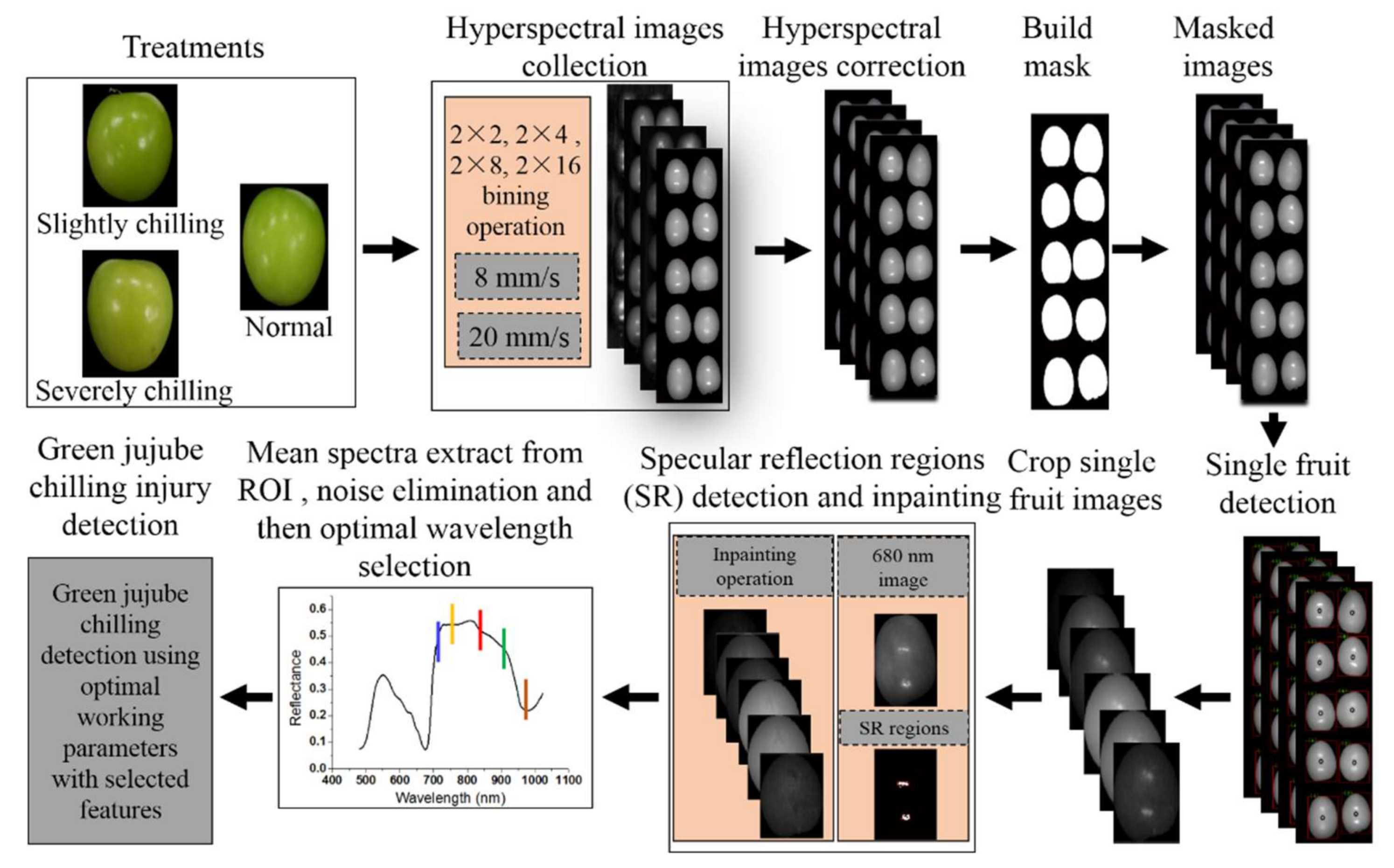
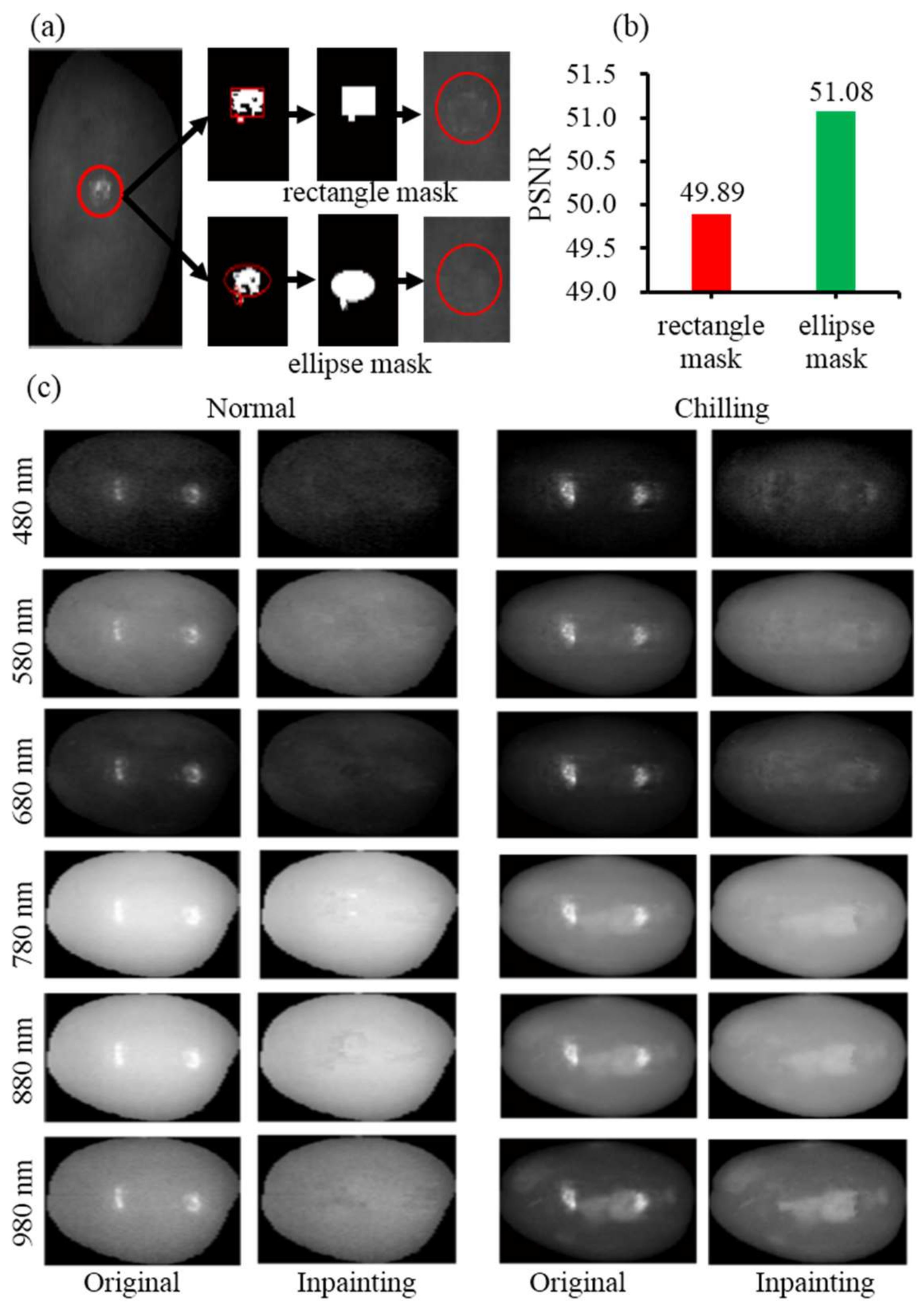
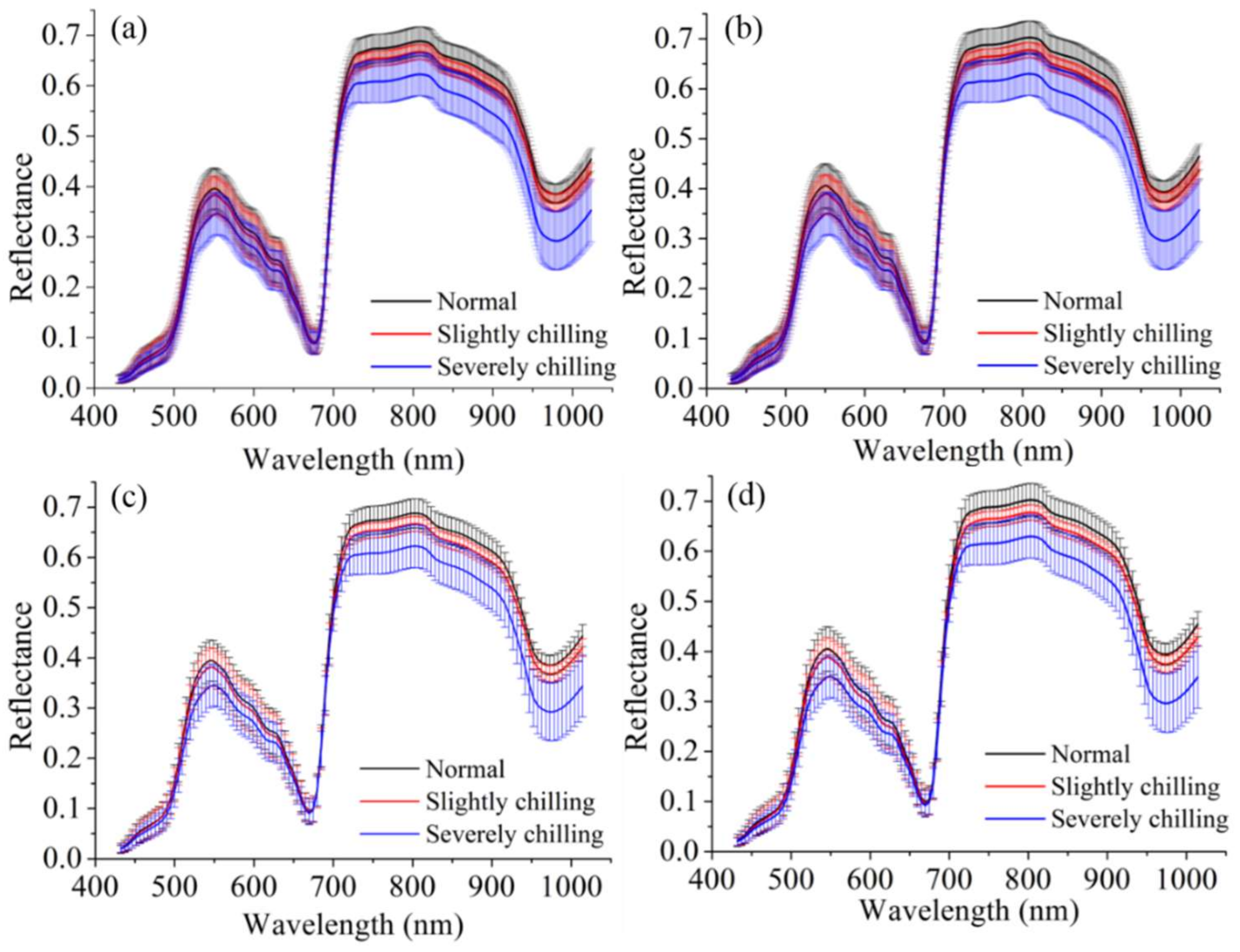
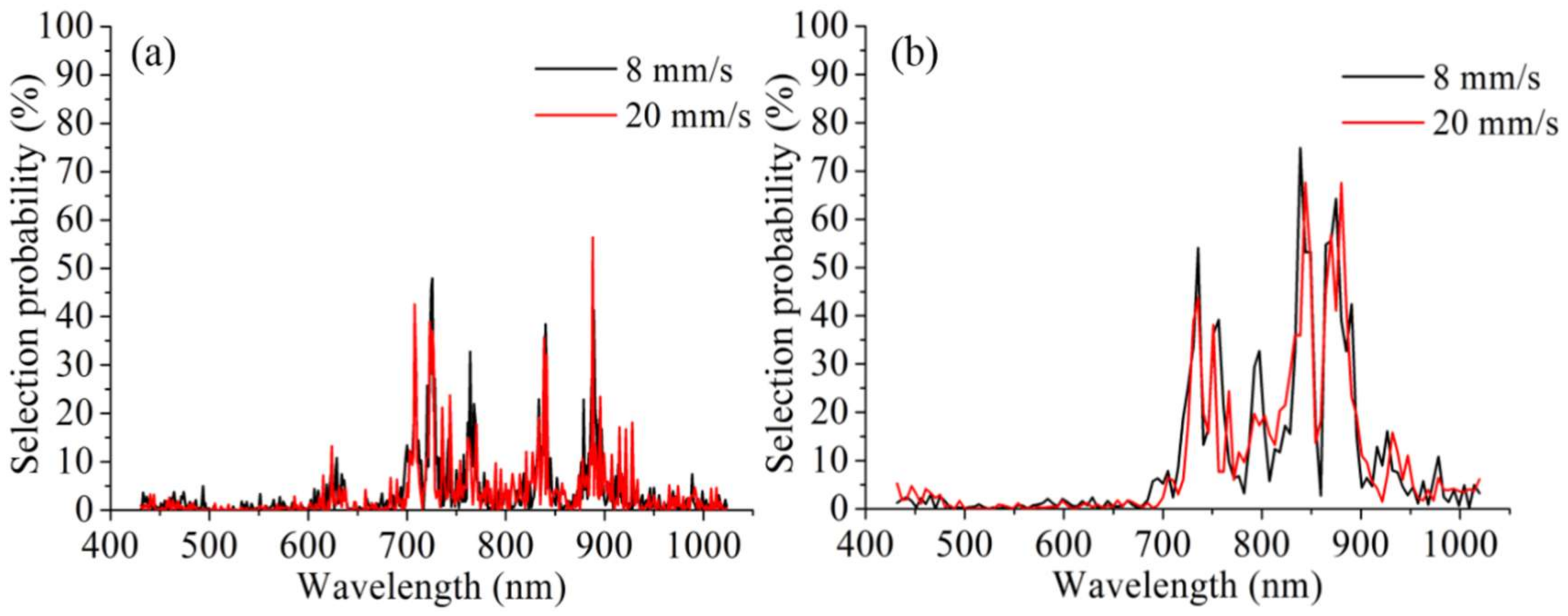
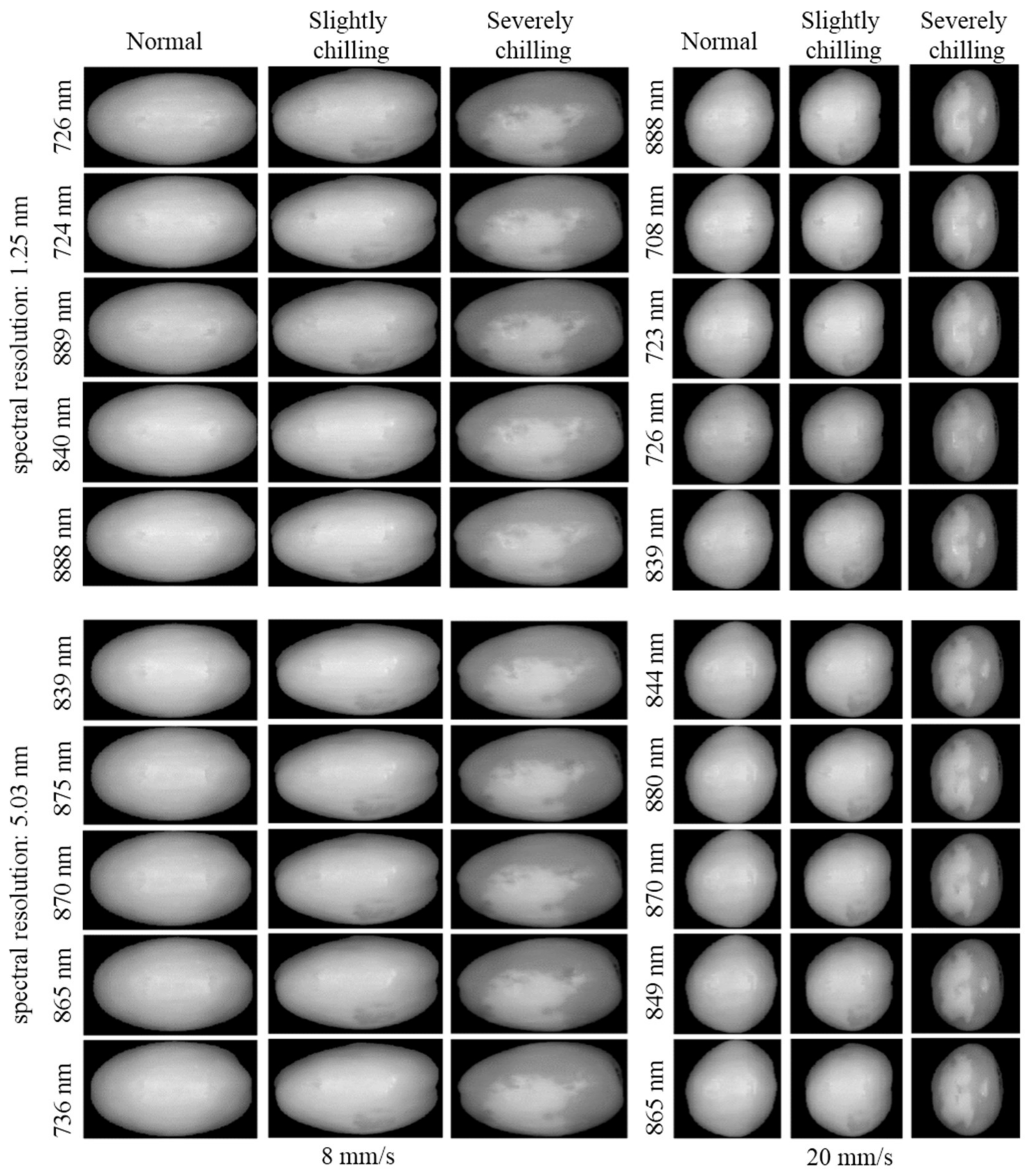
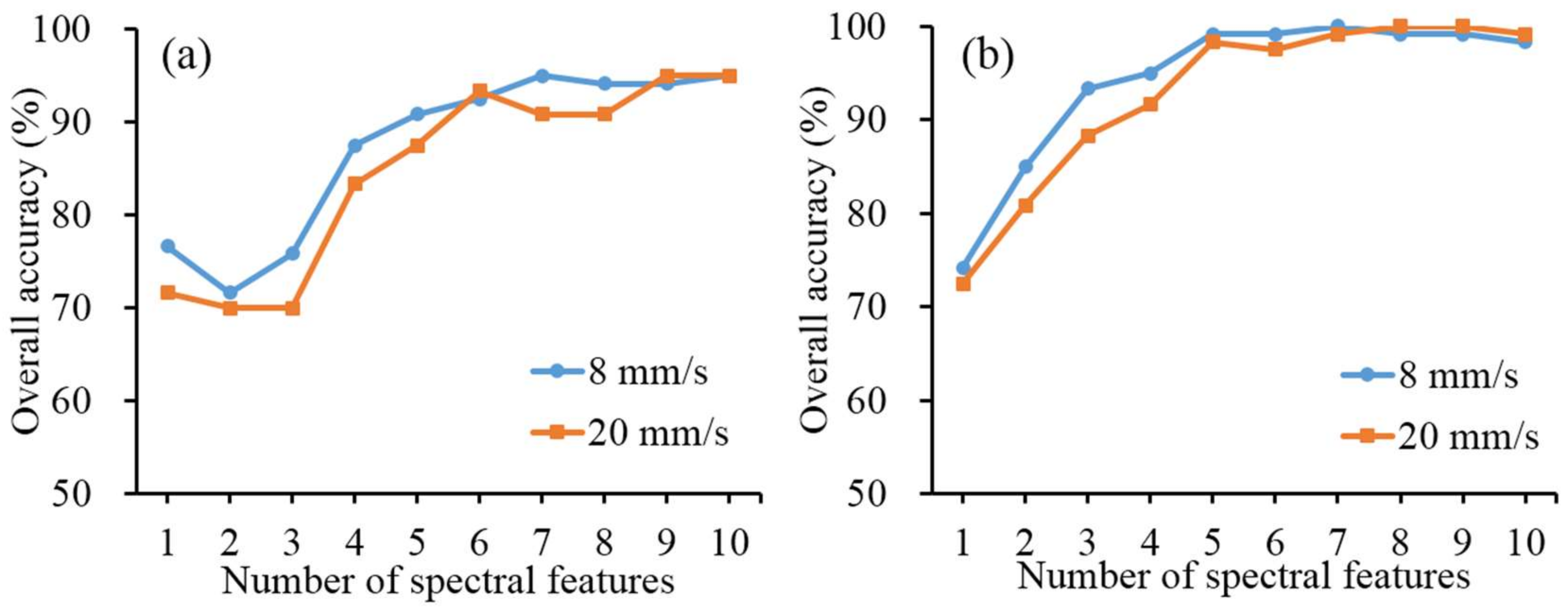
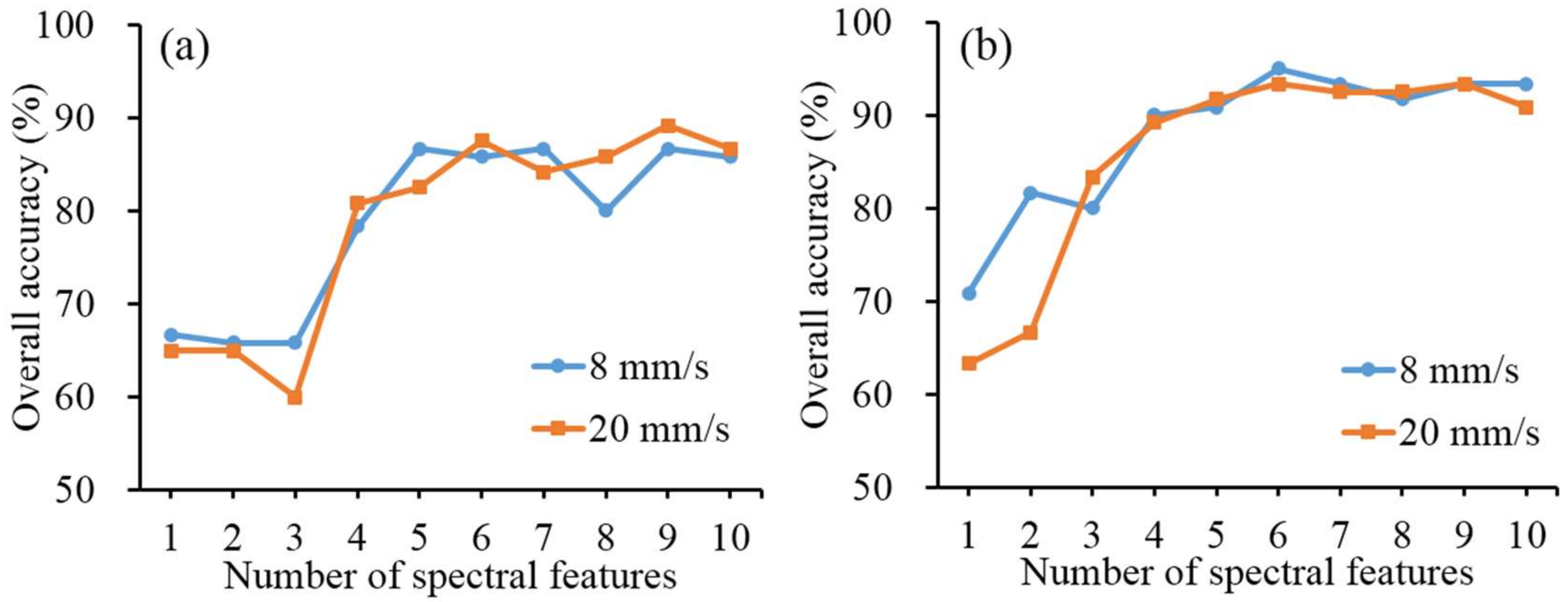
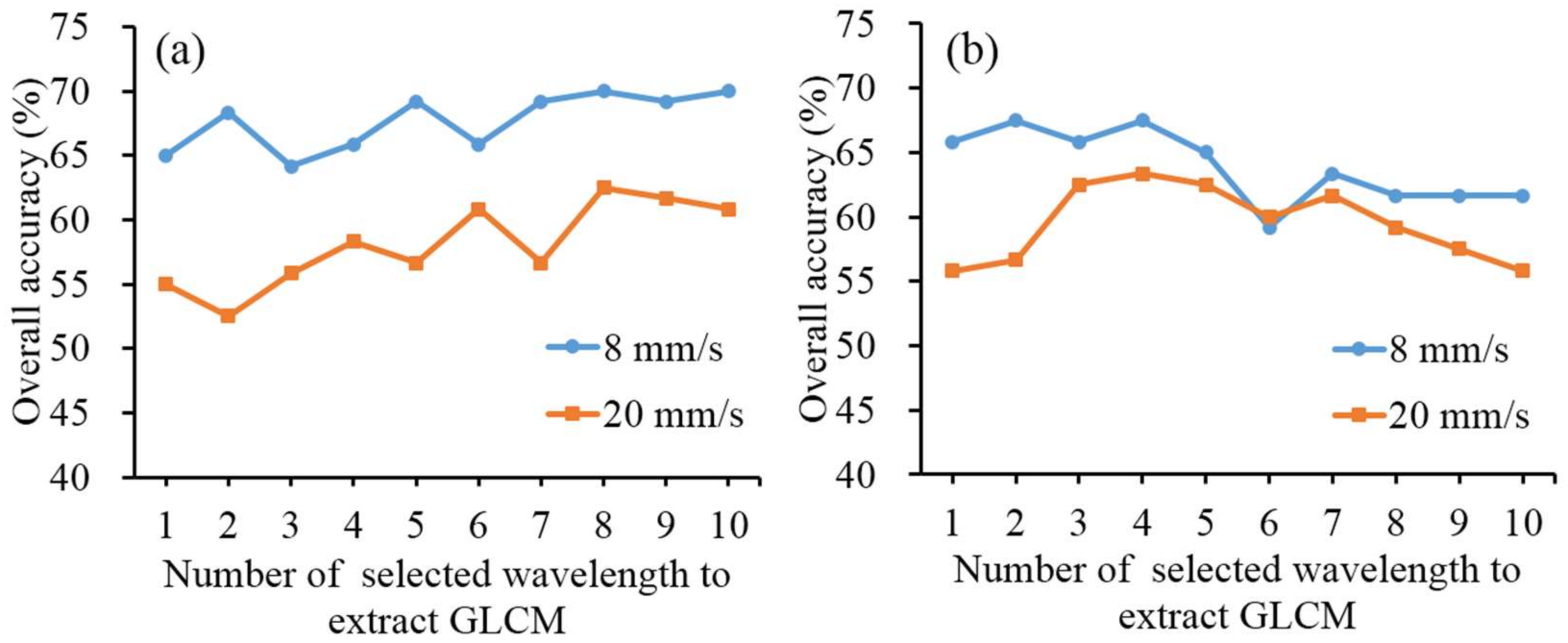
| Spectral Resolution (nm) | Speed (mm/s) | Wavelengths (nm) |
|---|---|---|
| 1.25 | 8 | 726, 724, 889, 840, 888, 764, 709, 723, 728, 841 |
| 20 | 888, 708, 723, 726, 839, 727, 841, 709, 724, 743 | |
| 5.03 | 8 | 839, 875, 870, 865, 736, 844, 849, 890, 756, 880 |
| 20 | 844, 880, 870, 849, 865, 736, 885, 875, 731, 751 |
| Prediction | Actual Class | |||||
| 1.25 nm, 8 mm/s a | 1.25 nm, 20 mm/s b | |||||
| Normal | Slightly Chilling | Severely Chilling | Normal | Slightly Chilling | Severely Chilling | |
| Normal | 41 | 2 | 0 | 40 | 2 | 0 |
| Slightly chilling | 3 | 44 | 6 | 3 | 45 | 5 |
| Severely chilling | 0 | 5 | 19 | 0 | 5 | 20 |
| Accuracy (%) | 93.2 | 86.3 | 76.0 | 93.0 | 86.5 | 80.0 |
| Prediction | 5.03 nm, 8 mm/s c | 5.03 nm, 20 mm/s d | ||||
| Normal | Slightly Chilling | Severely Chilling | Normal | Slightly Chilling | Severely Chilling | |
| Normal | 43 | 1 | 0 | 44 | 1 | 0 |
| Slightly chilling | 0 | 49 | 2 | 0 | 50 | 3 |
| Severely chilling | 0 | 3 | 22 | 0 | 4 | 18 |
| Accuracy (%) | 100 | 92.5 | 91.7 | 100 | 90.1 | 85.7 |
© 2018 by the authors. Licensee MDPI, Basel, Switzerland. This article is an open access article distributed under the terms and conditions of the Creative Commons Attribution (CC BY) license (http://creativecommons.org/licenses/by/4.0/).
Share and Cite
Lu, H.; Yu, X.; Zhou, L.; He, Y. Selection of Spectral Resolution and Scanning Speed for Detecting Green Jujubes Chilling Injury Based on Hyperspectral Reflectance Imaging. Appl. Sci. 2018, 8, 523. https://doi.org/10.3390/app8040523
Lu H, Yu X, Zhou L, He Y. Selection of Spectral Resolution and Scanning Speed for Detecting Green Jujubes Chilling Injury Based on Hyperspectral Reflectance Imaging. Applied Sciences. 2018; 8(4):523. https://doi.org/10.3390/app8040523
Chicago/Turabian StyleLu, Huanda, Xinjie Yu, Lijuan Zhou, and Yong He. 2018. "Selection of Spectral Resolution and Scanning Speed for Detecting Green Jujubes Chilling Injury Based on Hyperspectral Reflectance Imaging" Applied Sciences 8, no. 4: 523. https://doi.org/10.3390/app8040523






